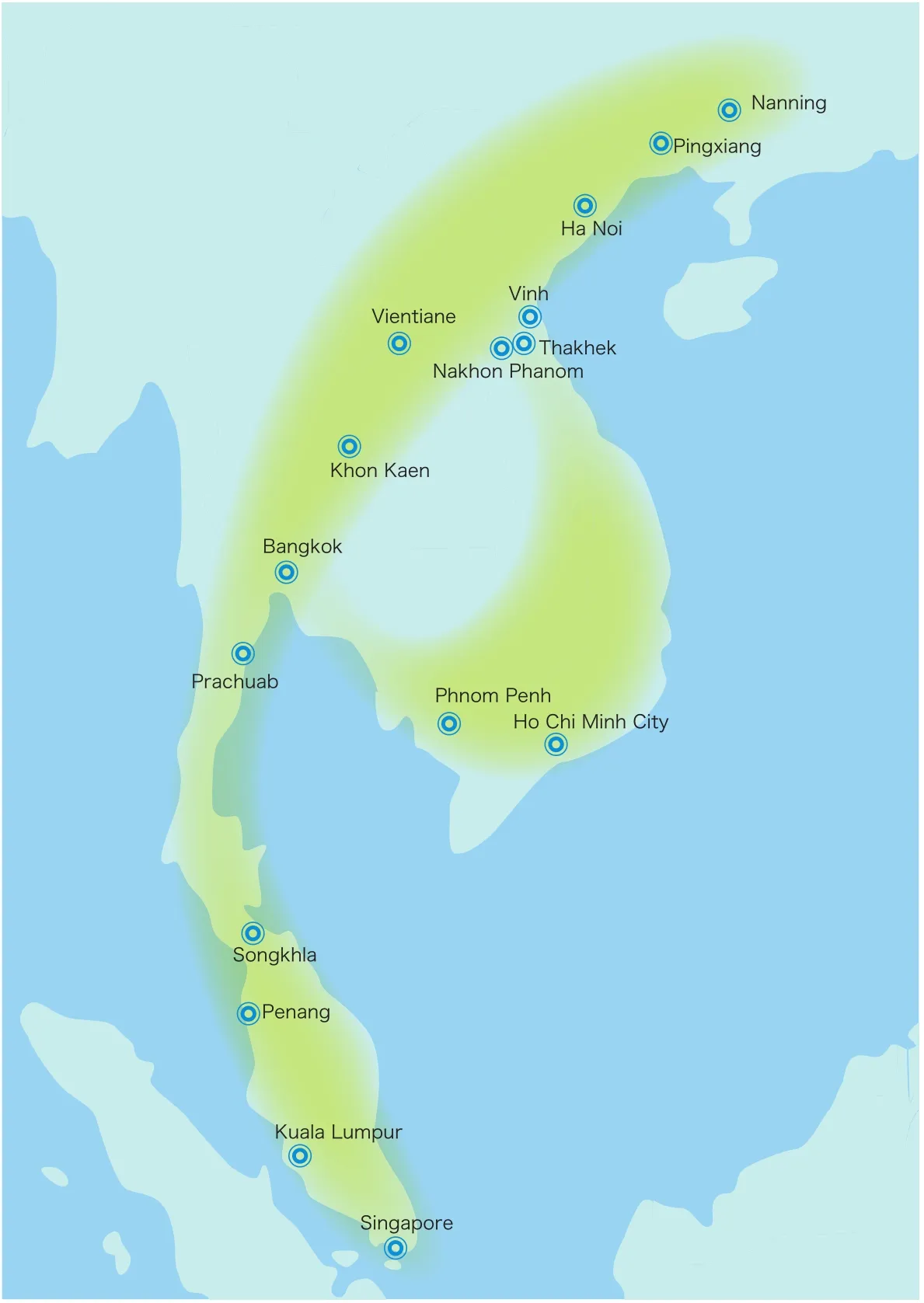“Connectivity, Cooperation, and Win-win”Major Breakthrough Has Been Achieved in the Construction of the Nanning-Singapore Economic Corridor
written by Lin Han / translated by Liu Yongjie, Xu Yuemeng
“Connectivity, Cooperation, and Win-win”Major Breakthrough Has Been Achieved in the Construction of the Nanning-Singapore Economic Corridor
written by Lin Han / translated by Liu Yongjie, Xu Yuemeng
In March 2015, the National Development and Reform Commission, Ministry of Foreign Affairs, and Ministry of Commerce of the People’s Republic of China issued “Vision and Actions on Jointly Building Silk Road Economic Belt and 21st-Century Maritime Silk Road” which clearly points out that the initiative of jointly building the Silk Road Economic Belt and the 21st Century Maritime Silk Road (hereinafter referred to as the “Belt and Road”) will focus on jointly building a new Eurasian Land Bridge and developing China-Mongolia-Russia, China-Central Asia-West Asia and China-Indochina Peninsula economic corridors by relying on core cities along the“Belt and Road” and using key economic industrial parks as cooperation platforms. For the time being, the China-Indo-China Peninsula International Economic Corridor that connects seven countries becomes the focus of mutual development of countries along the corridor.
The China-Indo-China Peninsula International Economic Corridor (Nanning-Singapore) Cooperative Development Round-table Conference was held in Nanning, China on September 18th. Centering on the theme of “Connectivity, Cooperation, and Winwin”, representatives from countries along the corridor engaged in in-depth discussions on the planning area and key construction projects of the economic corridor, infrastructure connectivity, customs clearance facilitation, trade and investment facilitation, cooperation on the construction of transnational and cross-border economic and trade parks and the establishment of working mechanisms, having reached broad consensus. A major step forward has been made in the construction of the Nanning-Singapore International Economic Corridor.

Nanning-Singapore Economic Corridor
Connectivity: Overcome Difficulties and Move towards Common Objectives
Connecting China, Vietnam, Lao PDR, Cambodia, Thailand, Malaysia and Singapore, and extending to Myanmar through an “east-west corridor”, the China-Indo-China Peninsula International Economic Corridor (Nanning-Singapore) runs through the China’s Pan-Pearl River Delta Region and countries on the Indo-China Peninsula.
However, the construction of the east China-Indo-China Peninsula Economic Corridor starting from Guangxi (Nanning-Singapore Economic Corridor) is relatively slow, compared with that of the west China-Indo-China Peninsula Economic Corridor starting from Kunming. A route construction plan that can be accepted by all the countries along the corridor has not been finalized, though the framework of the Nanning-Singapore Economic Corridor has taken shape. There is a long way to go for the basic road connectivity.
The connectivity between Guangxi and Vietnam is the key to promoting the road connectivity of the Nanning-Singapore Economic Corridor. In this regard, Li Yanqiang, Executive Deputy Director of Beibu Gulf Economic Zone & Cooperation with ASEAN Office of Guangxi Zhuang Autonomous Region, suggested that the construction of the east route should be prioritized, that is, building connectivity of the route starting from the Beibu Gulf Region to Thailand, Singapore and the ports along the coast of the Indian Ocean through Vietnam and Lao PDR. Objectively speaking, the conditions for constructing modern land transport passageways are excellent, as plains are the major geographic conditions along the route without the natural barrier of mountains. In the meantime, he also said,“We place emphasis on the planning of constructing the east route, which has to be integrated with the construction of the west route. The construction of the east and west routes should be carried out in coordination with different focus.”
Apart from the connectivity of communication and coordination mechanism as well as the road connectivity, trade and investment liberalization and facilitation needs to be promoted as well, as the Nanning-Singapore Economic Corridor can realize its huge potential only if the connectivity in the above three respects is achieved. Li Guanghui, Vice Dean of Chinese Academy of International Trade and Economic Cooperation (a think tank of the Ministry of Commerce), said, “Trade and investment liberalization and facilitation is a major goal of constructing the Nanning-Singapore Economic Corridor. Hence, all countries concerned should adopt measures to promote trade liberalization, eliminate various tariff and non-tariff barriers and create a regional environment of investment facilitation, promoting further integration and development of trade and economic cooperation among different countries.
Dinh Thi Ninh Giang, Deputy Director of the Ministry of Planning and Investment of Viet Nam, pointed out that in order to advance cooperation on development, countries along the corridor should actively participate in standardizing the construction of Nanning-Singapore Economic Corridor. The countries should create better conditions for transportation and cross-border business by formulating universal regional policies, work hard to improve trade and investment environment and adhere to all agreements, and pave the way for trade and investment through bilateral and multilateral channels.
Cooperation: Industrial Parks Serve as Platforms and Promote Industrial Integration and Upgrading
Seen from the overall situation, the construction of the Nanning-Singapore Economic Corridor will bring real and long-term benefits to the countries along the corridor, which is an opportunity for bringing the countries along the corridor together through industrial cooperation in all areas.
Prospects for industrial cooperation are bright, as there is a huge industrial gap between Guangxi and the countries along the Nanning-Singapore Economic Corridor, and the economies are more complementary than competitive. In this regard, Li Yanqiang noted that from the perspective of sub-regional cooperation, the Nanning-Singapore Economic Corridor is divided into three industrial classes: China’s Pearl River Delta, Thailand, Malaysia and Singapore belong to the first class, the labor-intensive and resource-intensive industries of which are gradually transferred to the second class – Guangxi and Vietnam – and the third class – Lao PDR, Cambodia and Myanmar. The establishment of the Nanning-Singapore Economic Corridor will turn the transport passageways of great potential into an economic corridor with bright prospects, taking on great importance in creating new areas of economic growth, promoting mutual development of countries along the corridor and bridging the gap between the rich and the poor.
Industrial parks are the platforms for industrial cooperation. At present, the China-Malaysia (Qinzhou) Industrial Park and the Malaysia-China Kuantan Industrial Park have been launched, planning to jointly build industrial parkswith Singapore and Thailand. In addition, China and Vietnam are speeding up the preparations for the cross-border economic cooperation of Pingxiang-Dong Dang and Dongxing-Mong Cai. Mongkol Tansuwan, Chairman of Northeast Chamber of Commerce, Thailand, gave an introduction to the establishment of the Nakhon Phanom Special Economic Zone, which is striving to become a distribution center for investment products, facilitating the flow of products between China and the ASEAN countries.
“‘Two Countries, Twin Parks’ creates a new model for international economic and trade cooperation in the new era, provides an effective platform for promoting international capacity cooperation and two-way investment between China and the ASEAN countries, which will certainly turn ‘Two Countries, Twin Parks’ into‘Two Countries, Many Parks’ and ‘Many Countries, Many Parks’ and play an exemplary and guiding role in serving the‘Belt and Road’ initiative and building an upgraded version of the China-ASEAN Free Trade Area (CAFTA),” said Gao Pu, Deputy Director of China-Malaysia (Qinzhou) Industrial Park Administration Committee.
Enterprises are the main body in industrial cooperation. At the China-Indo-China Peninsula International Economic Corridor (Nanning-Singapore) Cooperative Development Round-table Conference, some experts suggested that the countries concerned should advance the construction of the economic corridor by taking large-scale projects, take into account the cooperation among the enterprises of all countries in the construction process, form international competitiveness through cooperation among the enterprises, and jointly foster the leading force and development in the cooperation among the countries on the Indo-China Peninsula.
Win-win: Reach Consensus on Cooperation and Overcome Bottlenecks for Construction
Careful and adequate preparations should be made in advancing the construction of the China-Indo-China Peninsula International Economic Corridor, one of the six major land arteries of the “Belt and Road”, including a series of consensus, basic route planning, measurements of customs clearance facilitation and solutions to investment and fundraising. Only if countries along the corridor work together to offer suggestions and overcome the problems in the process of development can the new engine of China-ASEAN cooperation – the Nanning-Singapore Economic Corridor – start, so as to promote mutual development of the countries along the corridor.
At the Forum on Economic Cooperation of Beibu Gulf RIM held in July 2006, the vision of jointly building the Nanning-Singapore Economic Corridor and a new pattern of China-ASEAN regional economic cooperation of “One Axis, Two Wings” was put forward, which was highly acclaimed by the countries along the corridor. In July 2010, a team of experts from the relevant ministries of the central government and Guangxi carried out field work along the Nanning-Singapore Economic Corridor. In September 2014, a series of consensus was reached on jointly building the Nanning-Singapore Economic Corridor at the first Chinese (Nanning)-Singapore Economic Corridor Think Tank Summit and the Roundtable Conference of China-Singapore Economic Corridor.
At the China-Indo-China Peninsula International Economic Corridor (Nanning-Singapore) Cooperative Development Round-table Conference held on September 18th, 2015, representatives engaged in in-depth discussions on the planning area and key construction projects, infrastructure connectivity of the economic corridor, customs clearance facilitation, investment and trade facilitation, cooperation on the construction of transnational and cross-border trade and economic parks and the establishment of working mechanisms, having reached the consensus in five respects. A significant step forward has been made in the construction of the Nanning-Singapore Economic Corridor.
Investment and fundraising for the construction of the Nanning-Singapore Economic Corridor is a major topic for discussion at the roundtable conference. Countries along the Nanning-Singapore Economic Corridor are not rich, including such underdeveloped countries as Vietnam, Lao PDR and Cambodia. At the roundtable conference, representatives pointed out that investment and fundraising remained one of the most difficult problems for countries like Vietnam, Lao PDR and Cambodia, etc. in constructing and improving railways and roads.
With regard to how to overcome the bottlenecks for investment and fundraising, Li Bin, Vice Chairman of CPPCC Guangxi Zhuang Autonomous Region Committee, pointed out that we could work together to raise funds through multiple channels for the construction of Nanning-Singapore Economic Corridor. We should strive to enable the key construction projects of Nanning-Singapore Economic Corridor cooperation to be preferentially included in the overall arrangements of the Asian Infrastructure Investment Bank (AIIB), Silk Road fund and other China-ASEAN cooperation funds. We should give full play to the role of the AIIB in constructing the economic corridor and encourage the BRICS Development Bank and the World Bank to invest in the construction projects. In the meantime, he also suggested that we should encourage the fund to be raised by means of BOT and TOT, etc. and remove the bottlenecks for fundraising through multiple channels in constructing the Nanning-Singapore Economic Corridor.

